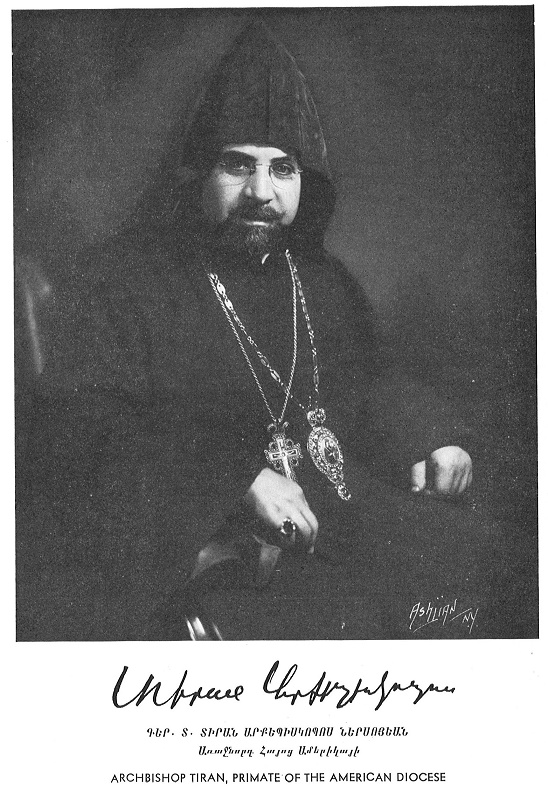
161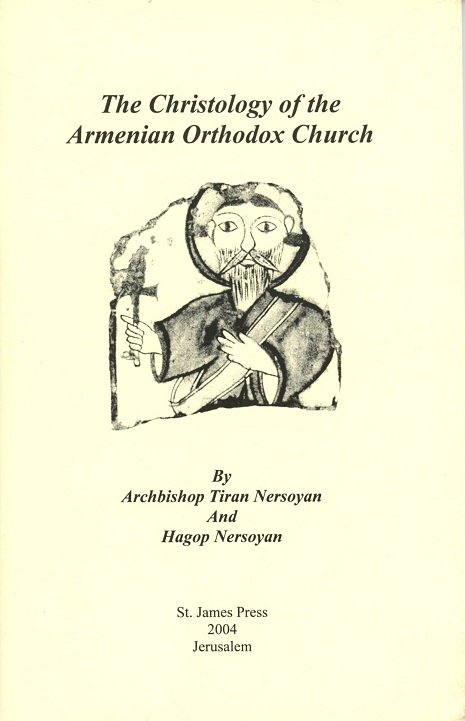 Rangement général
 | | The Christology of the Armenian Orthodox Church |
| Titre : | The Christology of the Armenian Orthodox Church / auteur(s) : Archbishop Tiran NERSOYAN - |
|---|
| Editeur : | St. James Press |
|---|
| Année : | 2004 |
|---|
| Imprimeur/Fabricant : | Jerusalem |
|---|
| Description : | 13,5 x 20 cm, 80 pages |
|---|
| Collection : | |
|---|
| Notes : | |
|---|
| Autres auteurs : | |
|---|
| Sujets : | |
|---|
| ISBN : | |
|---|
| Lecture On-line : | non disponible |
|---|
Commentaire : |
160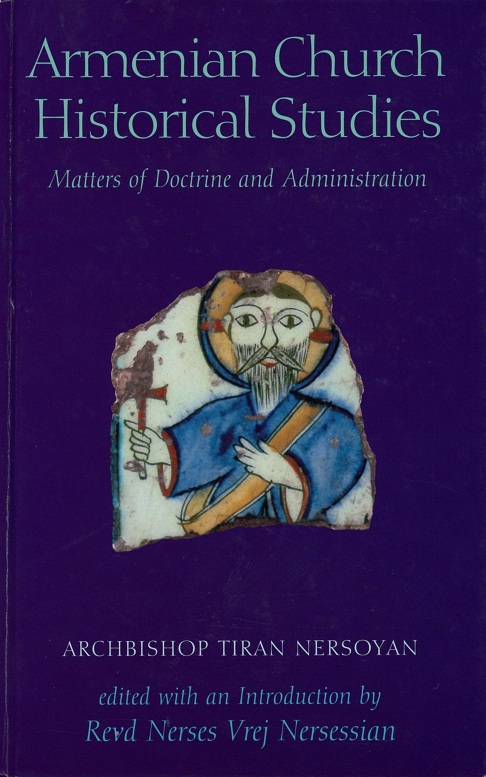 Rangement général
 | | Armenian Church Historical Studies - Matters of doctrine and administration |
| Titre : | Armenian Church Historical Studies - Matters of doctrine and administration / auteur(s) : Archbishop Tiran NERSOYAN - Edited with an introduction by Revf Nerses vrej Nersessian |
|---|
| Editeur : | St. Vartan Press |
|---|
| Année : | 1996 |
|---|
| Imprimeur/Fabricant : | New York |
|---|
| Description : | 14 x 22 cm, 459 pages, couverture illustrée en couleurs |
|---|
| Collection : | |
|---|
| Notes : | |
|---|
| Autres auteurs : | |
|---|
| Sujets : | Armenian Church -- Historical Studies |
|---|
| ISBN : | 0934728291 |
|---|
| Lecture On-line : | non disponible |
|---|
Commentaire :PrefaceThe idea of a volume containing the writings of the late Archbishop Tiran Nersoyan was initially thought of as early as 1979. In a letter dated 17 March 1979, the late Archbishop revised the content and order of the studies I had presented to him for his approval. To my initial list he added an unpublished study on 'St Nerses of Kla ("The Graceful")', which he intended to revise and prepare for publication but unfortunately never did. In the same letter he expressed regret for not having provided references to all his studies, as he had done in the case of his later publications. On the matter of the choice of title he expressed his preference to me in a letter dated 8 April 1980. It was to be Armenian Church Historical Studies, with the subtitle In Matters of Doctrine and Administration. In a note he also added, 'Perhaps we can say "essays" instead of "studies". But "essay" is defined as "literary composition". My writings can hardly come under that description.'
In connection with the abridgement of Archbishop M. Ormanian's Azgapatum (National history) in a 'book between 400-500 pages' on which we collaborated, he outlined his concept of doing history in a long letter. I wish to quote a passage from that letter:
Make a detailed table of contents and write it chapter by chapter and send to me piece by piece. I will criticize it and review it and return it to you. Historical records and the views of other historians are simply raw materials. The historian writing a book is an architect, who builds according to his perception his model of the past out of the materials available ... Hardened prejudices should be abandoned and our history should be located in the context of its time and environment often created by other forces. I like Hagop Manandyan as a historian, also Adontz. The primary sources lend themselves to a great deal of interpretations. [Letter of 23 February 1984]
The studies assembled in this volume should be read in the light of the author's definition of history.
I have attempted to give some stylistic unity to the volume, without altering the content. For the sake of uniformity I have used for the Armenian the transliteration system based on the phonetic values of the Armenian alphabet, avoiding the use of diacritical marks. I have edited the notes and extended some of them.
I am grateful to Archbishop Khajag Barsamian, Primate of the Diocese of the Armenian Church of America, and the Krikor and Clara Zohrab Information Center, New York, for their support and financial assistance.
N.V. Nersessian The British Library
Contents Preface I
Introduction 3
The Themes and Concerns of Armenian Theology in the Early Half of the Twentieth Century 3
History, Christ and Faith: The Theology of Archbishop Tiran Nersoyan 22
PART ONE: CHURCH HISTORY
The Apostolic Foundation of the Armenian Church 49
Summary Topics of Armenian Church History 63
The Armenian Church Since the First World War 91
The Paulicians 98
The Armenian Cathedral of St James in Jerusalem 109
PART TWO: CHRISTOLOGY
The Christological Position of the Armenian Church 127
The Lesson of History on the Controversy Concerning the Nature of Christ 144
Problems of Consensus in Christology: The Function of Councils 155
PART THREE: CANON LAW
A Brief Outline of the Armenian Liber Canonum and its Status in Modern Times 177
Problems and Exercise of Primacy in the Armenian Church 194
Laity in the Administration of the Armenian Church 235
The Administration and Governing Authority of the
Armenian Church 268
Notes on the Marriage and Celibacy of Priests 272
Interview Clarifies Position 296
PART FOUR: LITURGY
The Bible in the Armenian Church 303
The Psalms in the Armenian Church 311
The Structure of the Canonical Hours of the Armenian Church 315
A Brief Commentary on the Divine Liturgy of the Armenian Apostolic Church 326
The Analysis of the Divine Liturgy 340
A Brief Directorium with the Sunday Lections of the Midday Office 357
English Translations of the Armenian Liturgy 370
Books Utilized 371
PART FIVE: ARCHBISHOP TIRAN NERSOVAN'S LIFE AND WORKS by N.V. Nersessian
The Life and Career of Archbishop Tiran Nersoyan 375
A Bibliography of Tiran Nersoyan's Writings and Translations 386
Notes 398
Index of Names 441
Subject Index 451 |
154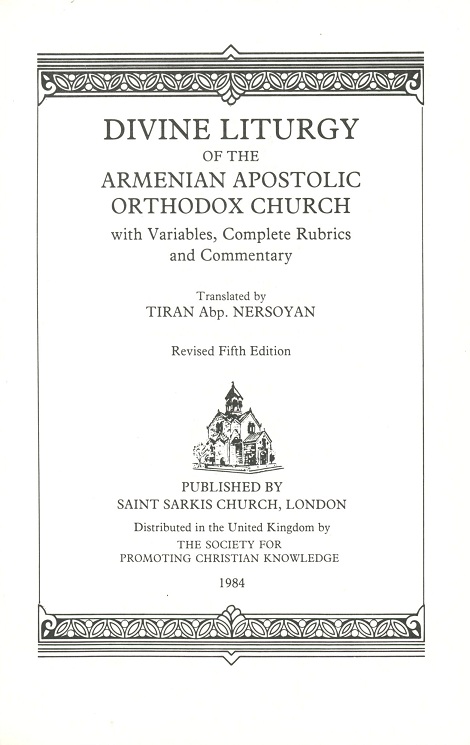 | | Divine Liturgy of the Armenian Apostolic Church |
| Titre : | Divine Liturgy of the Armenian Apostolic Church / auteur(s) : Archbishop Tiran NERSOYAN - With variables, complete rubrics and commentary |
|---|
| Editeur : | St Sarkis Church, London |
|---|
| Année : | 1984 |
|---|
| Imprimeur/Fabricant : | GB |
|---|
| Description : | 14 x 22 cm, 286 pages |
|---|
| Collection : | |
|---|
| Notes : | Bilingual Armenian-English, revised Fifth ediiton |
|---|
| Autres auteurs : | |
|---|
| Sujets : | Armenian Church -- Liturgy |
|---|
| ISBN : | |
|---|
| Lecture On-line : | non disponible |
|---|
Commentaire :PrefaceThe present translation of the Divine Liturgy of the Armenian Apostolic Orthodox Church has been made from the 'Mystery-Book' printed in Jerusalem in 1927 in accordance with the reading of the oldest texts under the supervision of the late Armenian Patriarch of Jerusalem, Archbishop Eghishe Durean( 1860-1930).
The Armenian Liturgy has had several translations into English. Almost all the previous translations are out of print. Some of them are incomplete, in that they do not contain the celebrant's secret prayers. Others are printed together with the liturgies of other churches and are intended for purposes of study by liturgists. All of them are arranged in a manner which is confusing to the reader, especially to those who try to use them for devotional purposes during the performance of the Sacred Liturgy. Above all, none of them is wholly satisfactory from the point of view of exactitude of rendering. In this respect the best among them are the works of F. E. Brightman and of F. Theodorus Isaac (Ter-Issahakian).
In making the present translation great pains have been taken to render the meaning of the Armenian text correctly and faithfully. We have not indulged in free rendition. For psalms King James' Version of the Bible has been followed, but only where it agrees with the Armenian Version which is a translation from the Septuagint. Where the Authorized Version clearly differs from the Septuagint, the Armenian reading has been preferred.
In one instance the Armenian text of the Liturgy has been corrected: the last line of the Cherubicon, which is borrowed from the Greek Liturgy of St. John Chrysostom, is devoid of meaning in the form in which it is ordinarily printed. We have reconstructed the line, in conformity with the Greek original. For the Armenian word, 'astuadsadsin', which is the familiar translation of the term theotokos, we have used the phrase Mother-of-God, because of the wide use of this latter title in the Western Church although theotokos could be translated better as 'Godbearer'. In the Bidding for the Kiss of Peace, in translating: 'and have gone outside the doors, pray', we have followed the text of Nersess of Lambron, by changing the place of the word 'and'. In the Prayer of Epiclesis we have rendered the word 'phokharkel', changing, although literally it means transposing.
The words 'hagiody' and 'hagiologize' have been coined in this translation to render the Armenian words 'srbasatsut'iwn'and srbaban line!', both denoting hymns of a special kind in which God's holiness is praised by singing 'holy' thrice, on the example of angels in heaven. The words 'economy', 'economize' have been used as literal translations of the word 'tnorinutiwn', 'tnorinel', or 'tntesel'(oikonomia in Greek), referring to the acts by which the Son subjected Himself to the laws and conditions of this world.
All matter enclosed within brackets are insertions by the translator. These insertions in the text are: (a) headings of different parts of the Liturgy, based on careful analysis; (b) rubrics which are in strict accordance with ceremonial usages prevalent in Armenian churches, at the present time, particularly in Jerusalem, and which, however, are not found in the texts we have used; (c) words which are explanatory of the cryptic phrases of the rubrics in the Armenian text.
All matter in the text which is not found in the 1927 Jerusalem edition of the 'Mystery-Book', but is found either in the 'Hours-Book' (Zhamagirq = Rrzvary) or in the 'Hymn-Book' (Tagharan), both printed and used in Jerusalem, has been enclosed in parentheses. Rubrics or textual matter from these books have been incorporated only when we have found these to be well established in current usage. These are considerable and in some cases important, although apparently later additions to the Liturgy.
The preponderant majority of the titles of the different parts and items of the Liturgy are well known and commonly accepted by liturgists. We have however found necessary to give titles of our own choosing to some items in order to make the Table of Analysis complete.
The broad outline of the brief commentary on the Divine Liturgy, containing some eucharistic doctrine is based on the text of the Liturgy, on historical data and especially on the commentaries of Xosrov of Andzev (950 A.D.) and of Nersess of Lambron (1177 A.D.). Only some of the minor points in this brief commentary constitute our own opinions.
We are indebted to Revd Dr. V. Nersessian for his assistance with the editing and production of this edition.
Contents Preface 9
Analysis of the Divine Liturgy 11
The Divine Liturgy 17
Memorial Office 115
Midday Office 125
Variables of the Divine Liturgy 141
Brief Directorium with Sunday Lections of the
Midday Office 185
Ritual of the Divine Liturgy 195
Practices related to the Celebration of the Divine Liturgy 237
Vestments and Vessels used in the Divine Liturgy 247
Brief Commentary 257
English translations of the Armenian Liturgy 285 |
155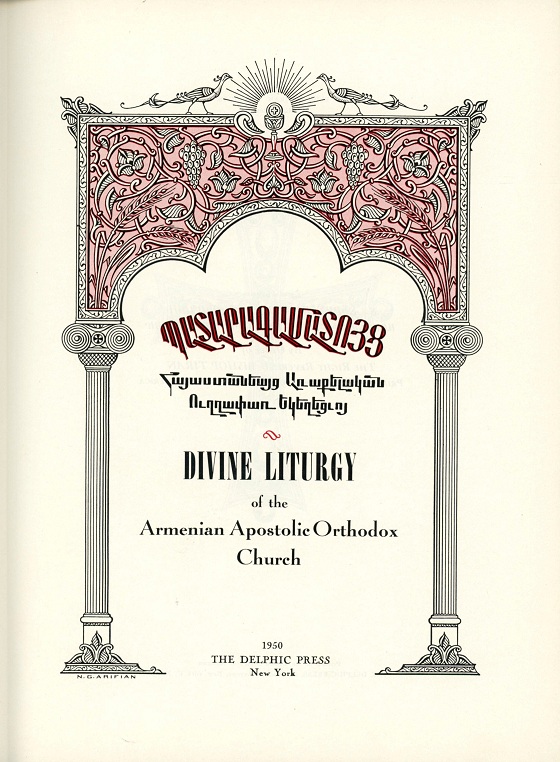 Rangement général
 | | Divine Liturgy of the Armenian Apostolic Church |
| Titre : | Divine Liturgy of the Armenian Apostolic Church / auteur(s) : Archbishop Tiran NERSOYAN - |
|---|
| Editeur : | Delphic Press, N Y |
|---|
| Année : | 1950 |
|---|
| Imprimeur/Fabricant : | USA |
|---|
| Description : | 20 x 26,5 cm314 pages |
|---|
| Collection : | |
|---|
| Notes : | Bilingual Armenian-English |
|---|
| Autres auteurs : | |
|---|
| Sujets : | Armenian Church -- Liturgy |
|---|
| ISBN : | |
|---|
| Lecture On-line : | non disponible |
|---|
Commentaire :Sacred Celebrant, please to remember in thy fervent prayers before the Immortal Lamb of God my beloved father resting in Christ, the late priest NERSES, and my beloved mother resting in Christ, ANNITZA, and my spiritual parent resting in Christ, the lord archbishop ELISEE, the Armenian Patriarch of Jerusalem
of blessed memory.
Also please to remember my humble and sinful self, TIRAN,
unworthy doctor and bishop of the Church, who has translated
and prepared this book of the Divine Liturgy for the benefit of the
children of the Holy Church.
Also remember them that have given their time and energy and have contributed in divers manners towards the publication of
this book.
And may the Lord remember all thy offerings and accept thy
sacrifice. Amen.
CONTENTS The Divine Liturgy or the Canon of the Ministration of the Church 5
The Service for the Repose of Souls 109
The Order of the Service of Jashou (The Synaxis) 119
The Variables of the Divine Liturgy Proper to Various Feast Days 129
Calendar and Table of Lections of Jashou 213
Dates for Easter, Assumption and Exaltation 229
The Analysis of the Divine Liturgy 231
First Lines of the Prayers, Biddings, Litanies, and Chants 235
The Ritual of the Divine Liturgy 243
A Note on the Armenian Church 245
Vestments and Vessels Used in the Divine Liturgy 246
Practices Related to the Celebration of the Divine Liturgy 257
The Ritual of the Service for the Repose of Souls 291
A Brief Commentary on the Divine Liturgy 293
On the Preparation of this Book 312 |
|
